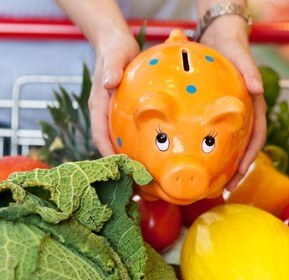While the rise in popularity of gluten-free foods has meant there is now more choice than ever the increase in food costs overall can be challenging for people living with coeliac disease or gluten intolerance. However, there are ways of living gluten-free on a budget, by sticking to natural foods, checking labels, buying in bulk, and reusing leftovers.
For many coeliacs, particularly in the weeks following diagnosis, the first shop and setting up a GF pantry can be daunting. That’s when the CNZ new member resources can be helpful.
With this in mind, we’ve asked some of our area coordinators for tips on how to live gluten-free on a budget and create delicious gluten-free meals without breaking the bank.
- Base your diet on whole foods and foods that are naturally gluten-free or gluten-free by ingredient instead of filling up on processed, gluten-free foods. Fruits, vegetables, meats, eggs, and rice are all examples of natural whole foods. Instead of using bread and pasta, gluten-free alternatives like potatoes and rice can be used to provide a source of carbohydrates for meals.
- Be prepared – buy or make safe GF food in advance of when you might need it and keep non-perishable snacks in your car or bag to avoid last-minute shopping for unexpected mealtimes away from home. Use up food already in the fridge when meal planning and before doing a big shop. Bulk buy seasonal produce when it is cheap and then preserve or freeze it for later use. Buy by unit price, and in bulk (but only when the unit price is cheaper).
- Incorporate cheap protein (beans, lentils, nuts, nut kinds of butter) and high-fiber foods into your diet to keep you fuller for longer so you eat less and are less likely to reach for expensive, processed GF snacks. Incorporate meatless meals into your weekly menu at least a couple of times a week.
- Shop around all the supermarkets, local shops, and online each time you do a big shop. Specialty food shops, many of which are online, can be cheaper than supermarkets (for example, Latin American stores for tortilla wraps or arepas, or Asian stores for GF flours) but check for gluten contamination. Fresh produce is often cheaper from local stalls, greengrocers, or online and compare prices with supermarkets each time as these may change.
- Consider alternatives – for example, powdered milk is often cheaper than fresh milk and can be used as a substitute in a lot of baking and cooking.
- Stretch meals with cheaper ingredients, such as frozen vegetables, seasonal produce, and canned lentils and beans.
- Learn to make your own bread, baking, and muesli as this is often cheaper than storebought or specialty shop alternatives. Create your own flour blend.
- The ingredient booklet that you receive in your CNZ membership pack or can be purchased online lists over 800 ingredients and 300 additives used in New Zealand and Australian foods and indicates whether they are safe for inclusion in a gluten-free diet.
- It’s essential that you become ingredient aware and an expert at reading labels and the CNZ community is here to help you. If you need help get in touch with your Area Volunteer Coordinator who is often more than happy to help out with a supermarket tour using our Buddy Shopper guide to assist you with understanding how to read ingredient labels and choose gluten-free brands.
- Buy ingredients on special and work your meals around these. Cook extra dinner and freeze the extra for later meals or use the next day as lunch or use little bits of leftovers in soups, salads, and rice bowls.
- Save GF baking fails to reuse – savoury fails can be turned into croutons or breadcrumbs; sweet fails can be used for trifles, mixed into crumble toppings, eaten as is with cream or ice cream, or mixed with milk and other add-ins to make milkshakes (nicer than it sounds!); both savoury and sweet fails can be blitzed into crumbs and mixed with butter to use as a base for tarts (savoury for savoury and sweet for sweet).
It may be worth seeing if you’re eligible for a food allowance. For coeliacs, there is the possibility of being eligible for an adult disability allowance (which is income-tested). There is also the children’s disability allowance (not income-tested) and the pharmac subsidy for flour and pasta.
Thanks to Beck Maarschalk for contributing to this article.

